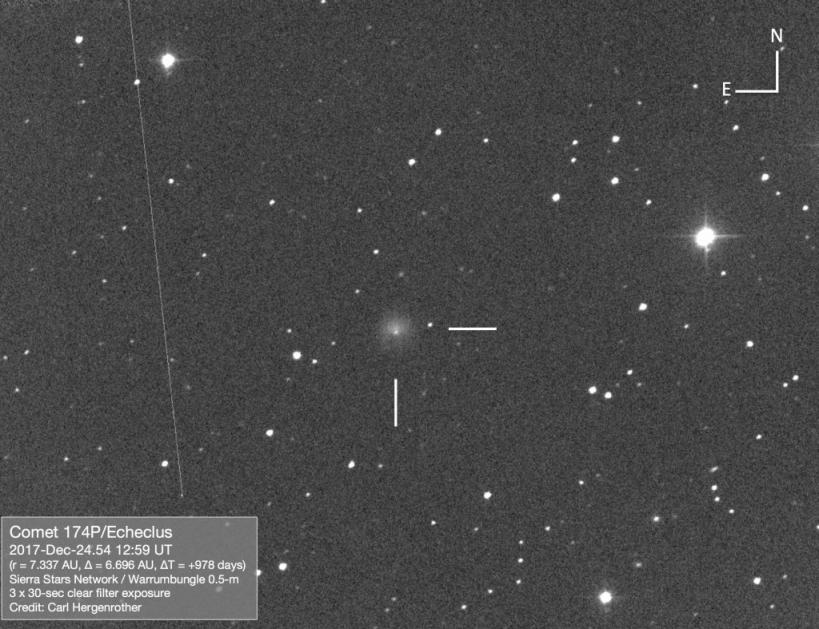ALPO COMET NEWS – JANUARY 2018
2018-January-1
Happy New Year! and Welcome to 2018. This year promises to be an exciting year for the Comet Section. New discovery C/2017 T1 (Heinze) is already bright enough for small telescope observers. Later in the year, the following comets should also become nice small telescope targets: 21P/Giacobini-Zinner (magnitude 6 in September), 38P/Stephen-Oterma (magnitude 9 in November), 46P/Wirtanen (magnitude 3 in December), 64P/Swift-Gehrels (magnitude 9 in October/November), C/2017 S3 (PANSTARRS) (magnitude 7 in August though it may get even brighter when too close to the Sun to be observable) and C/2017 T3 (ATLAS) (magnitude 8 in July/August). For large telescope and/or CCD observers, there are many dozens of comets that will become bright enough to observe this year.
Continuing our recent ALPO Comet News format, each release will concentrate on comets that are brighter than 12th magnitude. Fainter comets of interest may also be highlighted. This month four comets are expected to be brighter than 12th magnitude for part of the month: C/2017 T1 (Heinze), C/2016 R2 (PANSTARRS), 185P/Petriew and 62P/Tsuchinshan. At 13-14th magnitude, distant centaur comet 174P/Echeclus is once again in outburst.
Evening Comets
C/2017 T1 (Heinze) [Perihelion on 2018 February 21 at 0.58 au]
The new year kicks off with immediate action courtesy of comet C/2017 T1 (Heinze). As the month begins, you’ll have to battle the first Full Moon of January to see the comet. By the evening of the 2nd or 3rd, there should be enough dark time between the end of twilight and moonrise to grab a quick peak at Heinze. With a closest approach to Earth on January 4 at 0.22 au, the comet should brighten from magnitude 9.2 on the 1st to a peak of around 8.8 a week later. After that the comet will continue to approach the Sun (perihelion on February 21 at 0.58 au) but due to an increase in the comet-Earth distance (from the 0.22 au minimum to 0.79 au at the end of the month) the comet should experience a slow fade to magnitude 9.8 by February 1st.
Recent visual observations of Heinze from December 29 UT with 30×125 binoculars under a LM = 6.0 sky show it to be a rather diffuse (5′) low surface brightness object with little condensation or elongation. It is likely that observers under brighter skies and/or using high magnifications/large apertures will see the comet as much smaller and fainter.
Even with the bright Moon, CCD imagers may want to observe Heinze during the first few days of January. On January 3rd, the Earth passes through the comet’s orbit plane. As a result, the comet’s dust tail will be seen edge on. While dust tails seem to appear to be 3-dimensional tubes of material, in fact, they are usually 2-dimensional sheets. Similar to Saturn ring plane crossings, comet orbit plane crossings are when we are looking directly along the plane of the dust tail ’sheet’. On the days around orbit plane crossing, the dust tail will appear to narrow and may even grow in length as the surface brightness of the tail increases. CCD and large aperture visual observers will also notice the position angle of the tail rapidly swinging from the SSW on the 1st to nearly due east by the 10th.
Comet Heinze was discovered by Aren Heinze with the ATLAS (Asteroid Terrestrial-impact Last Alert System) survey on October 2nd at 18th magnitude. The comet appears to be intrinsically faint. Based on the first few orbits from the MPC, it also appeared to be dynamically new. The latest orbit (released on December 31) make it more likely that Heinze is a dynamically old comet. While faint dynamically new comets have a tendency of not surviving their perihelion passage, faint dynamically old comets should be robust enough to survive. Regardless, all observers are asked to keep a close watch on Heinze as it nears perihelion and to look for any changes in coma morphology that might suggest a splitting or disintegration event.
Heinze will be moving rapidly through the northern evening sky this month. It starts the month in Lynx (Jan 1-3) before moving through Camelopardalis (3-6), Cassiopeia (6-12), Andromeda (12-13), Lacerta (14-22) and Pegasus (22-31). Northern observers should be able to follow Heinze into early February before it gets too close to the Sun. After that it will be too far south for northern observers. Heinze might be glimpsed from mid-latitude observers in the southern hemisphere during the first day or two of January. The comet will again become visible to southern observers in mid to late March about 1 month after perihelion. By then the comet will have faded to 11th magnitude or fainter.
The ephemeris below (and for all following comets) was produced with Seiichi Yoshida’s ‘Comet for Windows’ program with my best estimate of each comet’s photometric parameters. Comet brightness forecasts are prone to error due to sudden outbursts and changes in brightness trends so don’t be surprised if a comet’s brightness deviates from what is shown below. Also it is suggested that you use your favorite online ephemeris generator or planetarium program to determine exact positions for your time of observation.
The image below was taken by ALPO Comet Section contributor Charles Bell on December 29 with a 0.3-m Schmidt-Cassegrain + CCD + R band filter. It consists of 48 x 12 second exposures. Charles maintains a very active and informative Twitter account focused on comet news and observations. I highly recommend it.
C/2016 R2 (PANSTARRS) [Perihelion on 2018 May 9 at 2.60 au]
Comet C/2016 R2 (PANSTARRS) was a bit of a sleeper for much of 2016. A dynamically old long-period comet, it was expected to brighten rapidly as it approached perihelion. Instead the comet intrinsically faded during the first three quarters of 2017. Starting in October, it rapidly brightened from magnitude 14 to 10.7. While not the brightest comet, it has entertained CCD imagers with an intricate and rapidly changing ion tail reminiscent of comets C/1908 R1 (Morehouse) and C/1961 R1 (Humason). All three comets share one trait that may explain their unusual tails, they are all very rich in CO+.
The comet is still about 5 months out from its May 9 perihelion at a rather distance 2.60 au. This month its heliocentric distance will drop from 2.93 to 2.80 au. Any intrinsic brightening will be partially countered by an increasing geocentric distance (increasing from 2.07 to 2.29 au). As a result, the comet should only brighten from about magnitude 10.7 to 10.4 this month. It is very possible that the comet may even fade in apparent magnitude if its recent rapid increase in intrinsic brightness moderates. This month PANSTARRS is an evening object spending the entire month in Taurus.
185P/Petriew [Perihelion on 2018 Jan 27 at 0.93 au]
Jupiter-family comet 185P/Petriew was a visual discovery by Canadian amateur astronomer Vance Petriew with his 20″ dobsonian while star hopping to the Crab Nebula (M1) at the 2001 Saskatchewan Summer Star Party. 185P/Petriew is on an orbit with a period of 5.5 years and is making its 4th observed return this year. With a perihelion distance of 0.93 au, this comet has peaked between magnitude 9 and 12 at each return. This year it should peak at magnitude 11 around the time of perihelion (January 27) and closest approach to Earth (mid-February at 1.33 au) when located in the western evening sky. It is interesting that this comet was not discovered till 2001. Its perihelion was 1.0 au or less for three returns prior to discovery (1984, 1990, 1996). The 1990 return was comparable to this year’s and the 1984 return was much better. For nearly a 100 years before 1984, it perihelion was larger but not by too much (between 1.21 and 1.40 au).
For the current return, few observations of this comet have been reported to, or at least published by, the usual astrometric and photometric archives (MPC, COBS, ICQ, BAA, German Comet Group, ALPO). According to past behavior, 185P should be near magnitude 12.0 at the start of the month and brighten to near magnitude 11.0 by the end of January. Once the Moon leaves the evening sky, it will be interesting to see how bright 185P really is. On January 1, the comet will be located 1.01 au from the Sun and 1.52 au from Earth. These distances drop to 0.94 au from the Sun and 1.36 au from Earth at the end of the month. The comet can be observed moving against the stars of Capricornus (Jan 1-8), Aquarius (8-31) and Pisces (31).
174P/Echeclus [Perihelion on 2015 April 21 at 5.81 au]
Centaur comet 174P/(60558) Echeclus orbits the Sun on a 35 year orbit that carries it from just outside the orbit of Jupiter to between the orbits of Saturn and Uranus. While not quite as outburst prone as 29P/Schwassmann-Wachmann 1, Echeclus has experienced a number of multi-magnitude outbursts since 2006. Brian Skiff of Lowell Observatory discovered a new outburst of Echeclus on December 7. Over the following days and weeks the object brightened to magnitude 13.5 to 14.0. CCD observers continue to image a slowly expanding cloud of dust. The cloud is expected to continue to expand and slowly fade this month. Echeclus is currently an evening object and can be found in Aries (Jan 1-31).
I was able to remotely image 174P on December 24 with a 0.51-m telescope located at Warrumbungle, Australia. The telescope is part of the Sierra Star Observatory Network.
Morning Comets
62P/Tsuchinshan [Perihelion on 2017 Nov 16 at 1.38 au]
Discovered photographically in 1965, 62P/Tsuchinshan (Chinese for Purple Mountain which is the name of the observatory where the discovery was made) is making its 9th observed return. The comet was observed between magnitude 10.5 and 11.5 from late October into December. This month, its heliocentric distance increases from 1.48 to 1.62 au while its geocentric distance drops from 1.20 to 1.11 au as it moves through Virgo (Jan 1-31) in the morning sky. The comet should fade by nearly a magnitude over the course of the month from around 11.1 to 11.9.
As always, the Comet Section is happy to receive all comet observations, whether images, drawings, magnitude estimates, and even spectra. Please send your observations via email to < carl.hergenrother @ alpo-astronomy.org >.
- Carl Hergenrother (ALPO Comet Section Coordinator)









